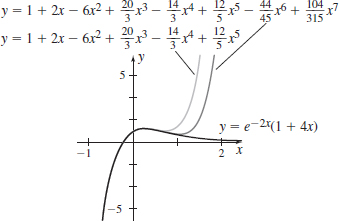16.5 Assess Your UnderstandingPrinted Page 1093
Skill Building
In Problems 1–12, use power series to solve each differential equation.
y′+3xy=0
y(x)=a0∞∑k=0(−32)kx2kk!
y′−x+3xy=0
y′′+y=0
y(x)=a0∞∑k=0(−1)kx2k(2k)!+a1∞∑k=0(−1)kx2k+1(2k+1)!
y′′+xy=0
y′′+x2y=0
y(x)=a0(1−x43⋅4+x83⋅4⋅7⋅8−x123⋅4⋅7⋅8⋅11⋅12+x163⋅4⋅7⋅8⋅11⋅12⋅15⋅16−⋯)+a1(x−x54⋅5+x94⋅5⋅8⋅9−x134⋅5⋅8⋅9⋅12⋅13+x174⋅5⋅8⋅9⋅12⋅13⋅16⋅17−⋯)
y′′−2xy=0
y′′+x2y′+xy=0
y(x)=a0(1−1⋅x32⋅3+1⋅4⋅x62⋅3⋅5⋅6−1⋅4⋅7⋅x92⋅3⋅5⋅6⋅8⋅9+1⋅4⋅7⋅10⋅x122⋅3⋅5⋅6⋅8⋅9⋅11⋅12−⋯)+a1(x−2⋅x43⋅4+2⋅5⋅x73⋅4⋅6⋅7−2⋅5⋅8⋅x103⋅4⋅6⋅7⋅9⋅10+2⋅5⋅8⋅11⋅x133⋅4⋅6⋅7⋅9⋅10⋅12⋅13−⋯)
y′′+3xy′+3y=0
y′′′+y=0
y(x)=a0(1−x33!+x66!−x99!+x1212!−⋯)+a1(x−x44!+x77!−x1010!+x1313!−⋯)+a2(x2−2⋅x55!+2⋅x88!−2⋅x1111!+2⋅x1414!−⋯)
y′′′−xy=0
(1+x2)y′′−4xy′+6y=0
y(x)=a0(1−3x2)+a1(x−13x3)
(x2+2)y′′−3xy′+4y=0
In Problems 13–22:
- (a) Use a Maclaurin series to find the solution of each differential equation using the given initial conditions.
- (b) Use the first five nonzero terms of the series to approximate values of y for 0≤x≤1. Use Table 1 as a guide.
y′′+xy′+y=0;y(0)=1,y′(0)=0
- (a) y(x)=1−12!x2+34!x4−156!x6+1058!x8−⋯
- (b)
x 0.0 0.1 0.2 0.3 0.4 0.5 0.6 0.7 0.8 0.9 1.0 y(x) 1.0000 0.9950 0.9802 0.9560 0.9231 0.8825 0.8353 0.7827 0.7262 0.6671 0.6068
y′′−2xy′+y=0;y(0)=2,y′(0)=1
y′′−(sinx)y=0;y(0)=0,y′(0)=1
- (a) y(x)=x+24!x4−46!x6+107!x7+68!x8+⋯
- (b)
x 0 0.1 0.2 0.3 0.4 0.5 0.6 0.7 0.8 0.9 1.0 y(x) 0 0.100008 0.2001 0.3007 0.4021 0.5051 0.6106 0.7195 0.8331 0.9527 1.0799
y′′+(cosx)y=0;y(0)=0,y′(0)=1
y′′+y′+exy=0;y(0)=2,y′(0)=1
- (a) y(x)=2+x−32!x2−14!x4+55!x5+⋯
- (b)
x 0.0 0.1 0.2 0.3 0.4 0.5 0.6 0.7 0.8 0.9 1.0 y(x) 2.0000 2.0850 2.1399 2.1648 2.1594 2.1237 2.0578 1.9620 1.8366 1.6823 1.5000
1094
y′′+(3+x)y=0;y(0)=1,y′(0)=0
y′′+x2y=0;y(0)=0,y′(0)=2
- (a) y(x)=2x−125!x5+5049!x9−55,44013!x13+11,642,40017!x17−⋯
- (b)
x 0.0 0.1 0.2 0.3 0.4 0.5 0.6 0.7 0.8 0.9 1.0 y(x) 0.0000 0.2000 0.4000 0.5998 0.7990 0.9969 1.1922 1.3832 1.5674 1.7415 1.9014
y′′−3x2y′+2xy=0;y(0)=1,y′(0)=1,
y(4)−ln(1+x)y=0;y(0)=1, y′(0)=1,y′′(0)=0,y′′′(0)=0
- (a) y(x)=1+x+15!x5+16!x6−17!x7+⋯
- (b)
x 0.0 0.1 0.2 0.3 0.4 0.5 0.6 0.7 0.8 0.9 1.0 y(x) 1.0000 1.1000 1.2000 1.3000 1.4001 1.5003 1.6007 1.7015 1.8031 1.9056 2.0095
y′′′+4y′′+2y′−x3y=0;y(0)=1,y′(0)=1,y′′(0)=0
Applications and Extensions
 Exact and Series Solutions
Exact and Series Solutions- (a) Use the first six terms of a Maclaurin series to approximate the solution of the differential equation y′′+4y′+4y=0 with the initial conditions y(0)=1 and y′(0)=2.
- (b) Solve the differential equation from (a) using a CAS.
- (c) Graph both the series solution from (a) and the exact solution from (b) on the interval [−1,2].
- (d) Comment on the graphs.
- (e) Repeat (a) using the first eight terms of a Maclaurin series.
- (f) Add the solution from (e) to the graph in (c). What is happening?
(a) y(x)≈1+2x−6x2+203x3−143x4+125x5
(b) y(x)=e−2x(1+4x)
(d) See Student Solutions Manual.
(e) y(x)≈1+2x−6x2+203x3−143x4+125x5−4445x6+104315x7
(c and f) The graphs are shown. See Student Solutions Manual for explanation.

 Exact and Series Solutions
Exact and Series Solutions- (a) Use the first six nonzero terms of a Maclaurin series to approximate the solution of the differential equation y′=xy(1−y2) with the initial condition y(0)=2.
- (b) Solve the differential equation from (a) using a CAS.
- (c) Graph the exact solution from (b) and the series solutions using two, four, and six nonzero terms on the interval [−2,2].
Challenge Problems
Age of the Earth's Crust. Uranium has a half-life of 4.5×109 years. The decomposition sequence is very complicated, producing a very large number of intermediate radioactive products, but the final product is an isotope of lead with an atomic weight of 206, called uranium lead.
- (a)
Assuming that the change from uranium to lead is direct, show that u=u0e−kt, l=u0(1−e−kt), where u and l denote the number of uranium and uranium lead atoms, respectively, present at time t. That is, assume dudt=−ku, where k>0 is a constant, and l=u0−u.
We can measure the ratio r=lu in a rock, and if it is assumed that all the uranium lead came from decomposition of the uranium originally present in the rock, we can obtain a lower bound for the age of Earth's crust. Currently, r≈0.054.
- (b) Show that this lower bound is given by t=1kln(1+r)=1k(r−r22+r33−⋯)>rk
- (c) What is this lower bound?
- (a)
- (a) See Student Solutions Manual.
- (b) See Student Solutions Manual.
- (c) The lower bound is 3.506×108 years.
